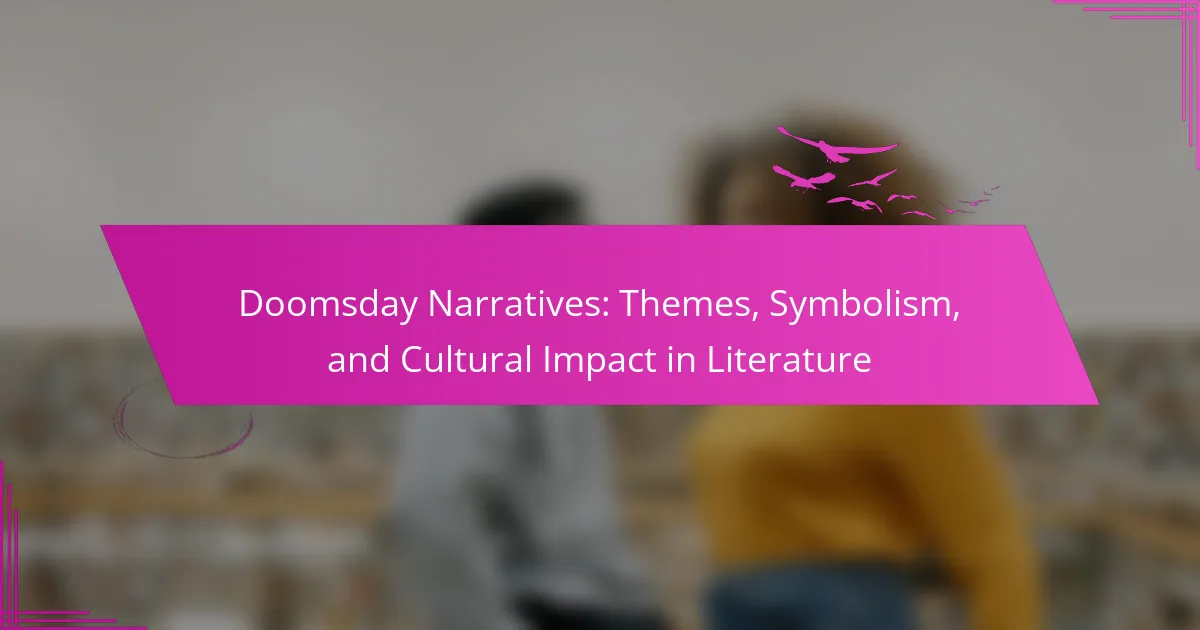Doomsday narratives explore profound themes of apocalypse, survival, and societal collapse, reflecting humanity’s fears about existential threats. They utilize symbolism, such as natural disasters and moral decay, to convey cultural anxieties. These narratives shape perceptions of risk and influence societal values, prompting reflection on environmental and social issues. Diverse cultural interpretations highlight unique beliefs about destruction and renewal, while emerging trends address contemporary fears surrounding climate change and technology.
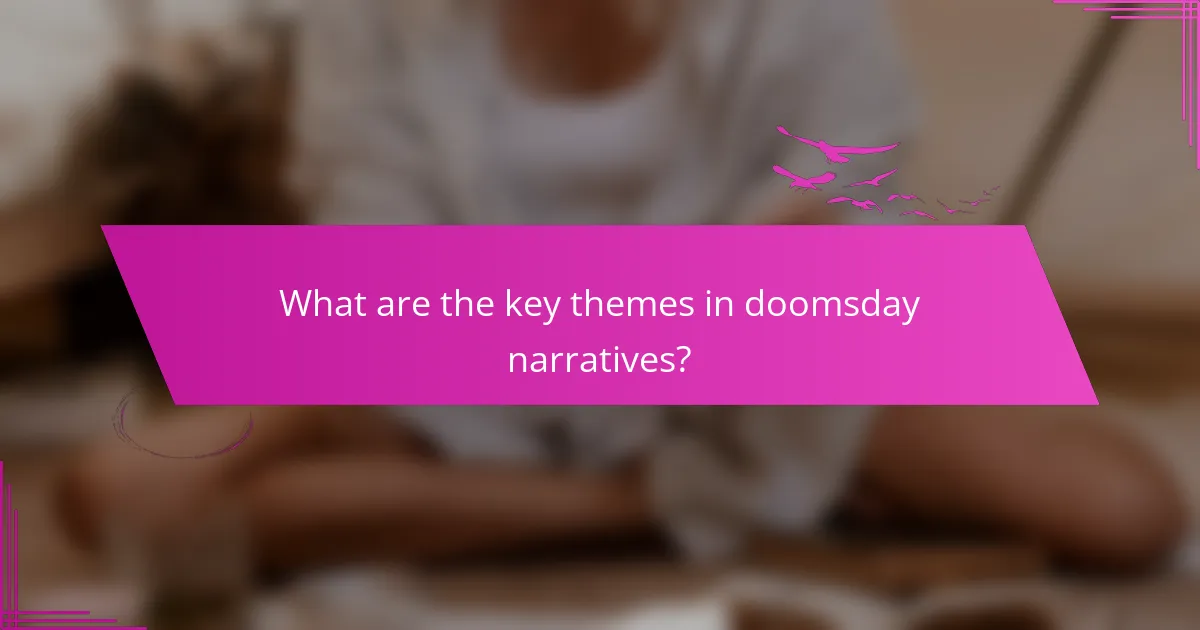
What are the key themes in doomsday narratives?
Doomsday narratives often explore themes of apocalypse, survival, and societal collapse. They reflect human fears about existential threats and the fragility of civilization. Common symbols include natural disasters, technological failures, and moral decay. These narratives impact culture by shaping perceptions of risk and influencing behaviours related to environmental and social issues.
How do apocalyptic scenarios reflect societal fears?
Doomsday narratives reflect societal fears by embodying anxieties about existential threats. These stories often symbolize cultural concerns, such as climate change, technological advancements, and societal collapse. Through themes of survival and moral dilemmas, literature explores the consequences of human actions. For instance, works like “The Road” illustrate the fragility of civilization, resonating with contemporary fears of environmental degradation. Additionally, these narratives serve as cautionary tales, prompting readers to confront their values and choices in the face of potential disaster.
What role does environmental degradation play in these stories?
Environmental degradation serves as a crucial backdrop in doomsday narratives, highlighting societal fears and consequences of human actions. It often symbolizes moral decay and the fragility of civilization. These stories reflect the potential repercussions of neglecting the environment, reinforcing themes of loss and despair. For instance, dystopian settings frequently depict barren landscapes, illustrating the stark reality of ecological collapse. This unique attribute enhances the narrative’s urgency, prompting readers to reflect on real-world environmental issues.
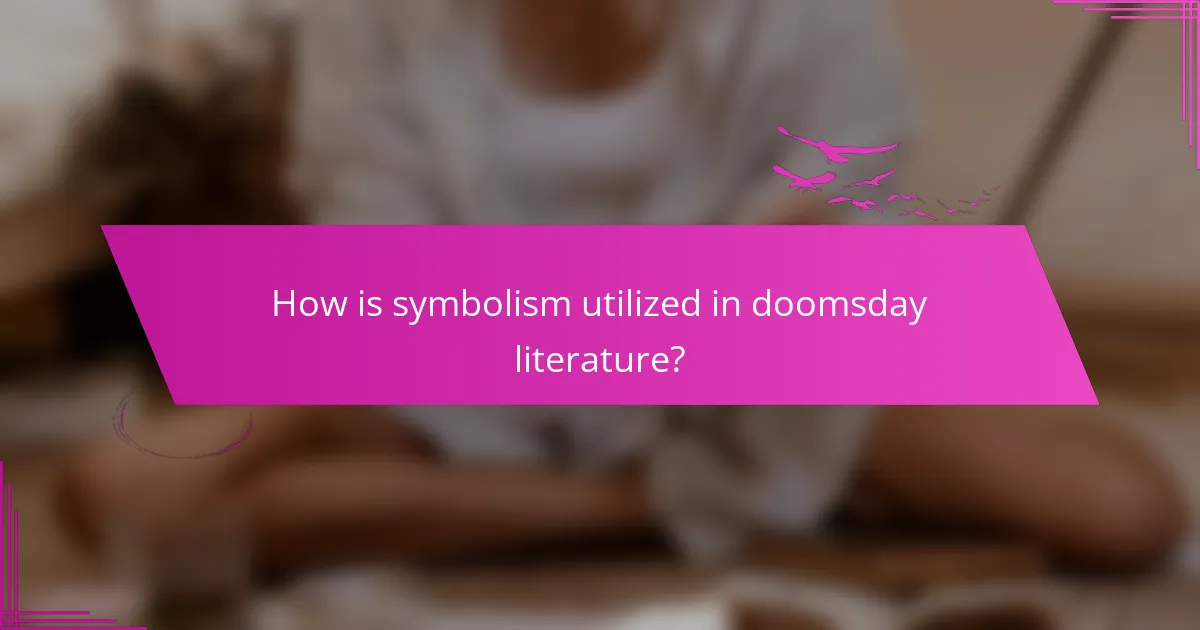
How is symbolism utilized in doomsday literature?
Symbolism in doomsday literature often represents existential themes and societal fears. Common symbols include apocalyptic imagery, natural disasters, and figures of destruction. These elements reflect cultural anxieties about the future and moral decay. For instance, fire frequently symbolizes purification or total annihilation, aligning with the narrative’s urgent tone. Such symbolism deepens the emotional resonance, allowing readers to explore complex themes of hope, despair, and renewal within the context of impending doom.
Which symbols are commonly associated with the end of the world?
Common symbols associated with the end of the world include the apocalypse, the four horsemen, fire, floods, and the phoenix. These symbols convey themes of destruction and rebirth in various cultural narratives. The four horsemen represent conquest, war, famine, and death, illustrating humanity’s struggles. Fire and floods symbolize catastrophic events that lead to transformation. The phoenix embodies renewal, suggesting that endings can lead to new beginnings. These symbols reflect deep-seated fears and hopes within literature.
How do different cultures interpret apocalyptic symbols?
Different cultures interpret apocalyptic symbols through their unique historical, religious, and social lenses. For instance, in Christianity, symbols like the Four Horsemen represent divine judgment, while in Hinduism, the concept of Kali Yuga signifies a period of moral decline. In Native American traditions, apocalyptic visions often focus on environmental harmony and renewal rather than destruction. These interpretations shape cultural narratives and influence literature, reflecting societal fears and hopes surrounding end times. As a result, apocalyptic themes resonate differently across cultures, revealing diverse perspectives on mortality and existence.
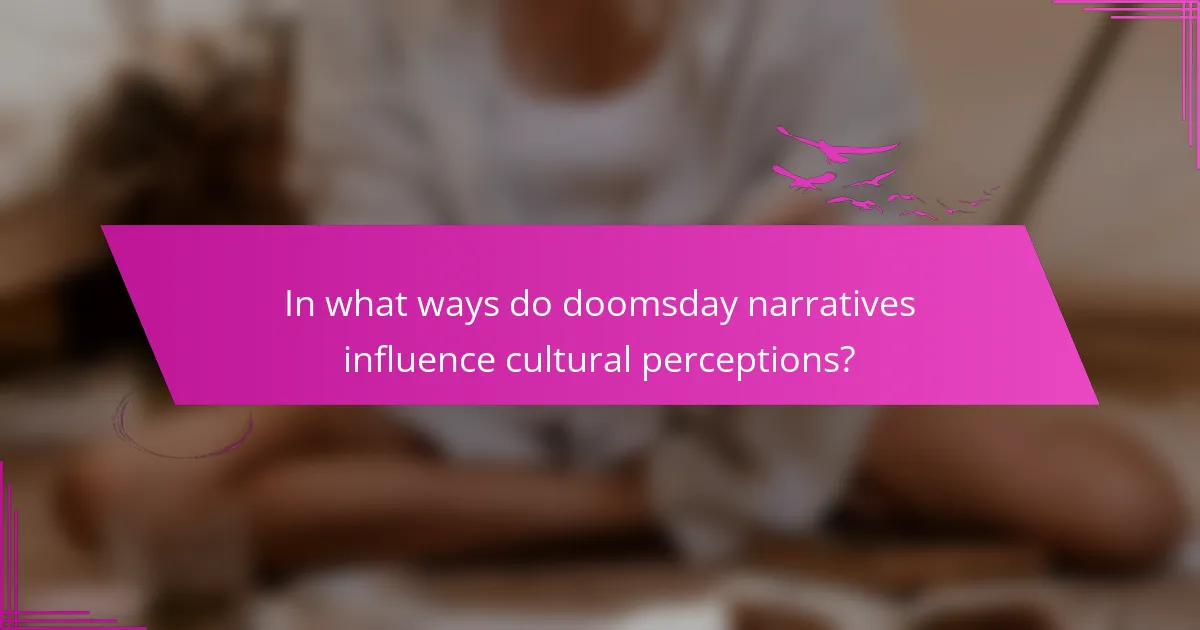
In what ways do doomsday narratives influence cultural perceptions?
Doomsday narratives shape cultural perceptions by instilling fear and prompting reflection on societal values. They often explore themes of apocalypse, survival, and morality, influencing collective consciousness. For example, literature like “The Road” by Cormac McCarthy illustrates human resilience amid devastation, reinforcing the importance of hope. Such narratives often symbolize existential threats, prompting discussions about environmental issues and social justice. As a result, they can mobilize communities toward action or reflection, ultimately impacting cultural identity and values.
How do these narratives shape public discourse on climate change?
Doomsday narratives significantly influence public discourse on climate change by instilling urgency and fear. These themes often highlight catastrophic consequences, shaping perceptions and motivating action. For example, literature depicting apocalyptic scenarios can galvanize communities to advocate for environmental policies. Symbolism in these narratives, such as the imagery of a dying planet, resonates emotionally, making abstract concepts more tangible. This cultural impact fosters a collective consciousness that prioritises climate action, as individuals feel a personal stake in the future.
What impact do they have on political movements?
Doomsday narratives significantly influence political movements by shaping public perception and mobilising action. These narratives often invoke fear and urgency, prompting collective responses to perceived threats. For example, climate change doomsday scenarios have galvanised environmental activism, leading to policy changes and grassroots movements. Additionally, these themes can unify disparate groups under a common cause, fostering solidarity. The symbolism of impending doom resonates deeply in cultural contexts, motivating individuals to engage politically. Such narratives also highlight societal anxieties, reflecting and amplifying existing political tensions.

Which notable works exemplify doomsday narratives?
Notable works exemplifying doomsday narratives include “The Road” by Cormac McCarthy, “Station Eleven” by Emily St. John Mandel, and “The Stand” by Stephen King. These texts explore themes of survival, societal collapse, and human resilience. “The Road” presents a bleak post-apocalyptic landscape, while “Station Eleven” examines the impact of a pandemic on civilization. “The Stand” juxtaposes good versus evil in a world ravaged by a superflu. Each work contributes to the cultural understanding of existential threats and human response.
How do contemporary authors reinterpret traditional apocalyptic themes?
Contemporary authors reinterpret traditional apocalyptic themes by infusing modern societal issues and diverse perspectives. They often explore environmental degradation, technological anxieties, and social inequalities through symbolic narratives. For instance, novels like “The Road” by Cormac McCarthy depict a desolate future, reflecting on human resilience amid collapse. Additionally, authors emphasise character-driven stories, shifting focus from grand cataclysms to personal survival. This approach fosters a deeper emotional connection, allowing readers to engage with the implications of societal choices. Ultimately, these reinterpretations challenge readers to reflect on current realities and potential futures.
What are the characteristics of dystopian literature in relation to doomsday?
Dystopian literature often portrays a bleak future shaped by societal collapse, environmental disaster, or authoritarian regimes. Key characteristics include themes of oppression, survival, and moral ambiguity. Symbolism frequently highlights the fragility of civilization, showcasing how human nature can lead to destruction. The cultural impact is profound, reflecting societal fears and prompting discussions about ethics and governance.

How do doomsday narratives vary across different cultures?
Doomsday narratives vary significantly across cultures, reflecting unique beliefs and values. Common themes include apocalyptic visions, divine judgment, and renewal.
In Western cultures, narratives often focus on biblical prophecies, such as the Book of Revelation, emphasising a final battle between good and evil. In contrast, many Eastern traditions, like Hinduism and Buddhism, portray cyclical destruction and rebirth, highlighting the impermanence of existence.
Indigenous cultures frequently incorporate environmental elements, viewing doomsday as a consequence of human actions against nature. This perspective emphasises harmony with the Earth and the need for sustainable living.
These variations illustrate how cultural contexts shape the interpretation of doomsday, influencing societal responses to existential threats.
What unique attributes do indigenous doomsday stories possess?
Indigenous doomsday stories often possess unique attributes that reflect cultural values and environmental contexts. These narratives frequently incorporate themes of renewal and cyclical time, emphasising a connection to nature. They may also feature distinct symbolic elements, such as animals or natural disasters, that resonate with specific cultural beliefs. Additionally, these stories often serve as cautionary tales, warning against societal transgressions. The integration of oral traditions and communal storytelling enhances their impact, fostering a shared identity among indigenous peoples.
How do religious texts portray apocalyptic events?
Religious texts often portray apocalyptic events through vivid imagery and symbolic language, emphasising themes of judgment, renewal, and divine intervention. These narratives reflect cultural fears and hopes, shaping societal values. For instance, the Book of Revelation in the Christian tradition presents a unique attribute of a final battle between good and evil, symbolising ultimate justice. Similarly, the Quran describes rare attributes of resurrection and accountability, highlighting moral lessons. Such texts influence literature and art, inspiring countless interpretations and adaptations across cultures.
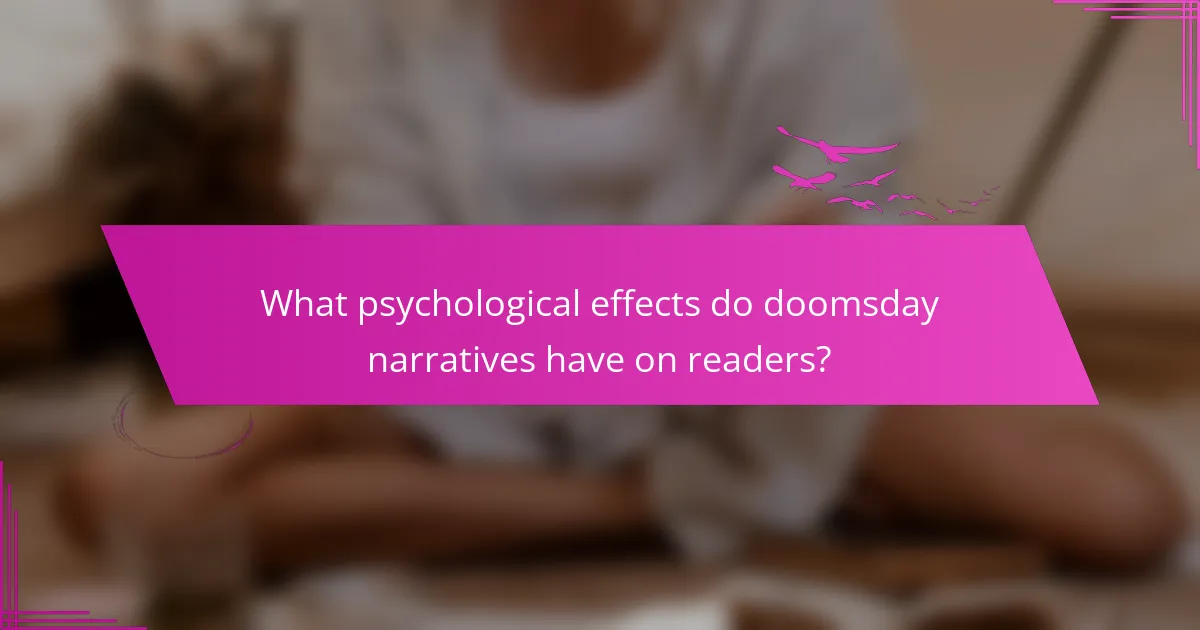
What psychological effects do doomsday narratives have on readers?
Doomsday narratives can induce anxiety, fear, and a sense of helplessness in readers. These themes often evoke existential dread, impacting mental well-being. The symbolism of impending doom can lead to heightened stress levels, as individuals grapple with their mortality and the fragility of society. As a result, readers may experience a range of psychological effects, including increased paranoia and a distorted perception of reality.
How do these narratives influence anxiety and fear?
Doomsday narratives significantly influence anxiety and fear by amplifying existential concerns. These stories often embody themes of catastrophe and loss, which resonate deeply with readers. The symbolism of inevitable doom creates a psychological impact, leading to heightened feelings of uncertainty and dread. Cultural contexts further shape these narratives, often reflecting societal fears and anxieties, thereby reinforcing the emotional responses they evoke. As a result, individuals may experience increased anxiety levels as they confront the bleak realities depicted in such literature.
What coping mechanisms are portrayed in literature?
Literature often portrays coping mechanisms such as denial, acceptance, and resilience in doomsday narratives. These themes explore how characters respond to catastrophic events, reflecting human psychology. Denial manifests as characters refuse to acknowledge impending doom, while acceptance shows them confronting reality. Resilience highlights the strength to endure despite despair. These coping strategies deepen the narrative, illustrating cultural impacts and societal responses to existential threats.
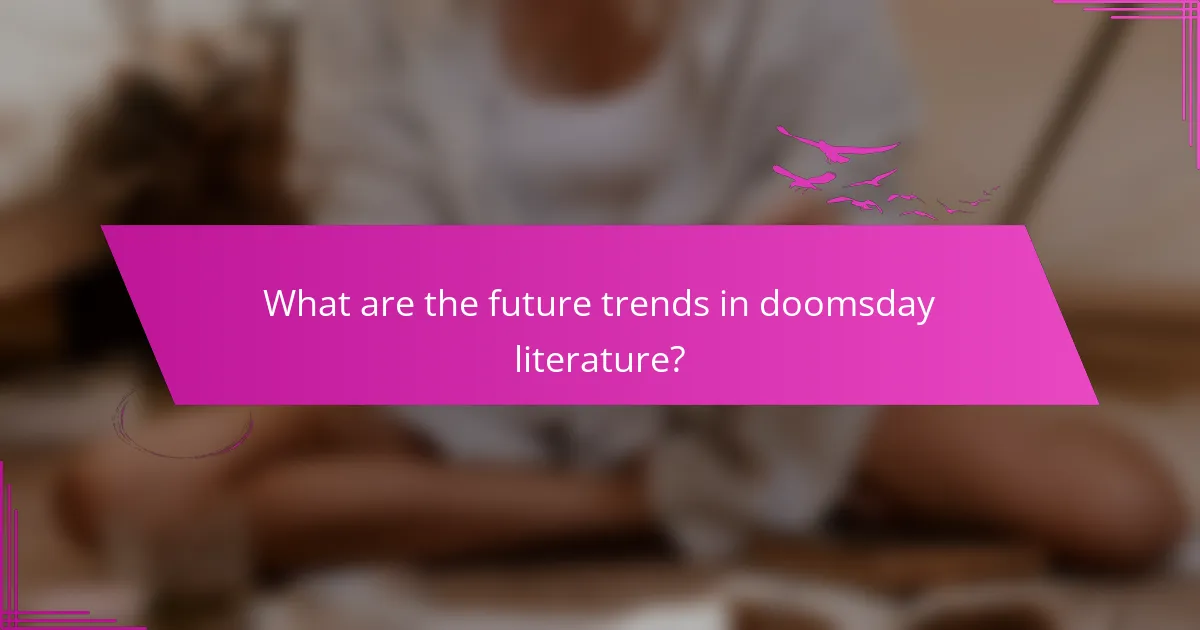
What are the future trends in doomsday literature?
Future trends in doomsday literature will focus on climate change, technological dystopias, and societal collapse. These narratives will increasingly reflect global anxieties and cultural shifts. The rise of eco-apocalyptic themes highlights environmental concerns, while stories centred on artificial intelligence will explore the consequences of unchecked technological advancement. Additionally, diverse voices will emerge, offering unique perspectives on survival and resilience. As a result, doomsday literature will evolve to address contemporary fears and ethical dilemmas, making it more relevant than ever.
How might emerging technologies shape new apocalyptic stories?
Emerging technologies will significantly influence new apocalyptic stories by introducing novel themes and symbols. These technologies, such as artificial intelligence and virtual reality, reshape narratives around human survival and ethical dilemmas. For instance, AI-driven scenarios may explore the consequences of autonomous decision-making in crisis situations. Virtual reality can immerse audiences in post-apocalyptic worlds, enhancing emotional engagement and reflection on societal values. Additionally, biotechnology may lead to narratives focusing on genetic manipulation and its implications for humanity’s future. Overall, these advancements will deepen the cultural impact of doomsday narratives by prompting critical discussions on technology’s role in shaping human destiny.
What role will climate fiction play in the evolution of doomsday narratives?
Climate fiction will significantly shape doomsday narratives by blending cautionary tales with imaginative solutions. This genre reflects societal anxieties about climate change, often depicting dystopian futures. It serves as a cultural mirror, prompting reflection on environmental issues. Themes of resilience and adaptation emerge, offering hope alongside the despair of potential catastrophes. As a result, climate fiction enriches the discourse around survival and responsibility, influencing how audiences perceive and respond to real-world challenges.
What best practices should writers follow when crafting doomsday narratives?
Writers crafting doomsday narratives should focus on creating compelling themes and rich symbolism. They must establish a vivid atmosphere that resonates with cultural anxieties and existential fears. Integrating relatable characters enhances emotional engagement, while exploring moral dilemmas can provoke thought. Additionally, grounding narratives in realistic scenarios can amplify their impact.
